Reading skills are crucial to a student’s long-term success in the classroom and beyond. While IXL aligns with a variety of curriculums, standards, and pedagogies, its alignment with best practices in reading science ensure that early learners can build a strong foundation in literacy.
According to reading research, effective instruction must address five critical areas, including:
- phonemic awareness
- phonics
- fluency
- vocabulary
- comprehension
IXL ELA skills are carefully designed to help early elementary students master each of the five areas above through explicit instruction and immediate feedback.
And IXL works! Research shows IXL ELA positively impacts early literacy development. Specifically, students who answered more IXL questions performed better on the Star Early Literacy Assessment and saw greater literacy growth compared to students who answered fewer IXL questions.
Below, we’ll dive into how IXL supports learning in each of the five areas listed above.
Phonemic awareness
Phonemic awareness refers to the understanding that words are made up of phonemes (sounds). Phonemic awareness skills are one of the best predictors of later reading success, and explicit instruction in phonemic awareness directly impacts reading achievement.
IXL offers a number of phonemic awareness skills where students practice blending and segmenting, as well as phoneme identification. For example, in this skill, students practice sound matching and learn to identify the beginning sounds in words:
Which two words start with the same sound? (JMR)
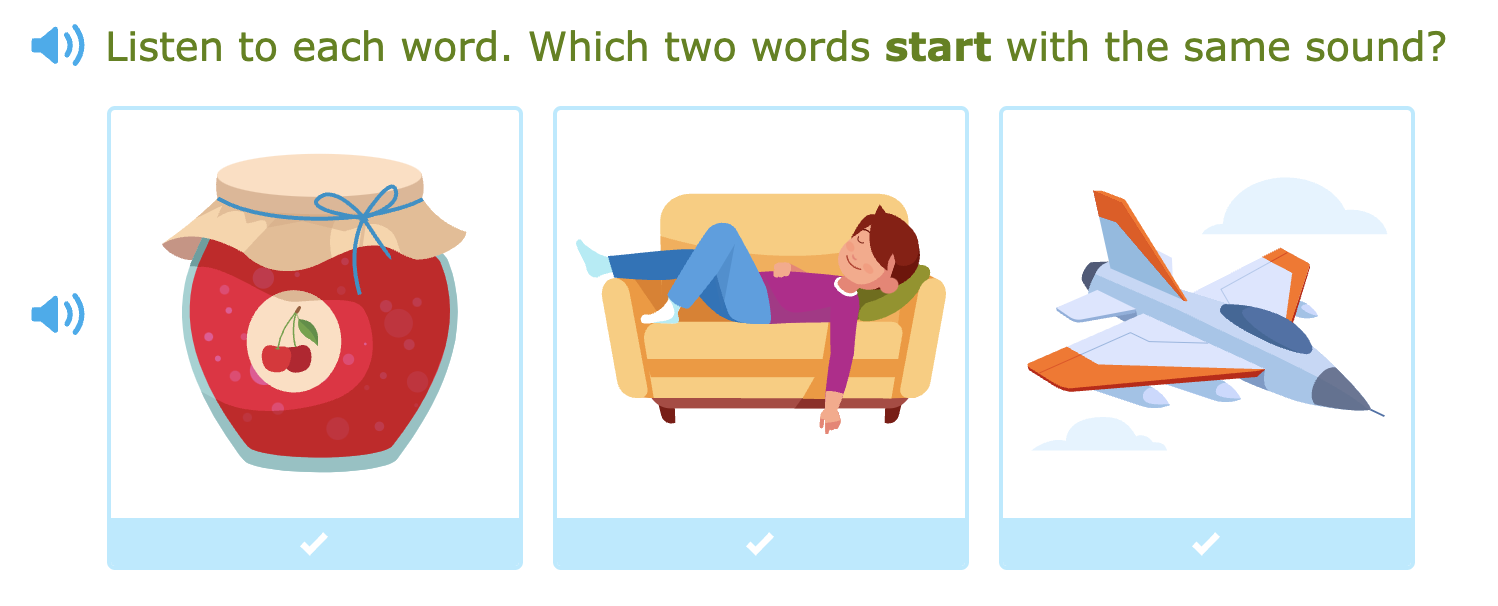
IXL’s tutorial videos also provide explicit phonemic awareness instruction. Before practicing the skill above, students can click on “Watch a video” to see a Wyzant tutor model how to listen for and identify the beginning sounds in words. The video shows students how to feel what their mouths are doing to help them identify sounds.

You can learn more about our ELA video tutorials here!
Phonics
Decades of research on early literacy indicate that phonics instruction is the most effective way to teach students the basic mechanics of reading. This instruction must be explicit and systematic in order to be successful. In other words, students should be directly taught the rules and associations between letters and sounds, and instruction should follow a logical sequence from simple to more complex, allowing students to work through concepts in a structured, systematic way.
Explicit
IXL’s robust phonics program includes numerous skills that explicitly teach the relationship between letters and sounds. These targeted skills cover all major phonics concepts, from letter-sound correspondences to more advanced concepts like vowel teams, diphthongs, R-controlled vowels, multisyllabic words, and more.
For example, in this skill, students learn about the letter-sound correspondences for the digraphs sh, ch, and th:
Choose the correct digraph (NTC)

And in this skill, students read sentences with vowel team words.
Choose the vowel team sentence that matches the picture (MU2)

You’ll notice that the IXL tutorial videos that accompany phonics skills—like those above— explicitly teach students how to map letters to sounds. For example, before practicing the digraph skill above, students can watch a video that introduces them to the digraphs ch, sh, and th in a fun and engaging way.

Finally, above every IXL skill, you’ll find the “learn with an example” button. Here, students can access an example question, brief overview of the skill concept, and solution.
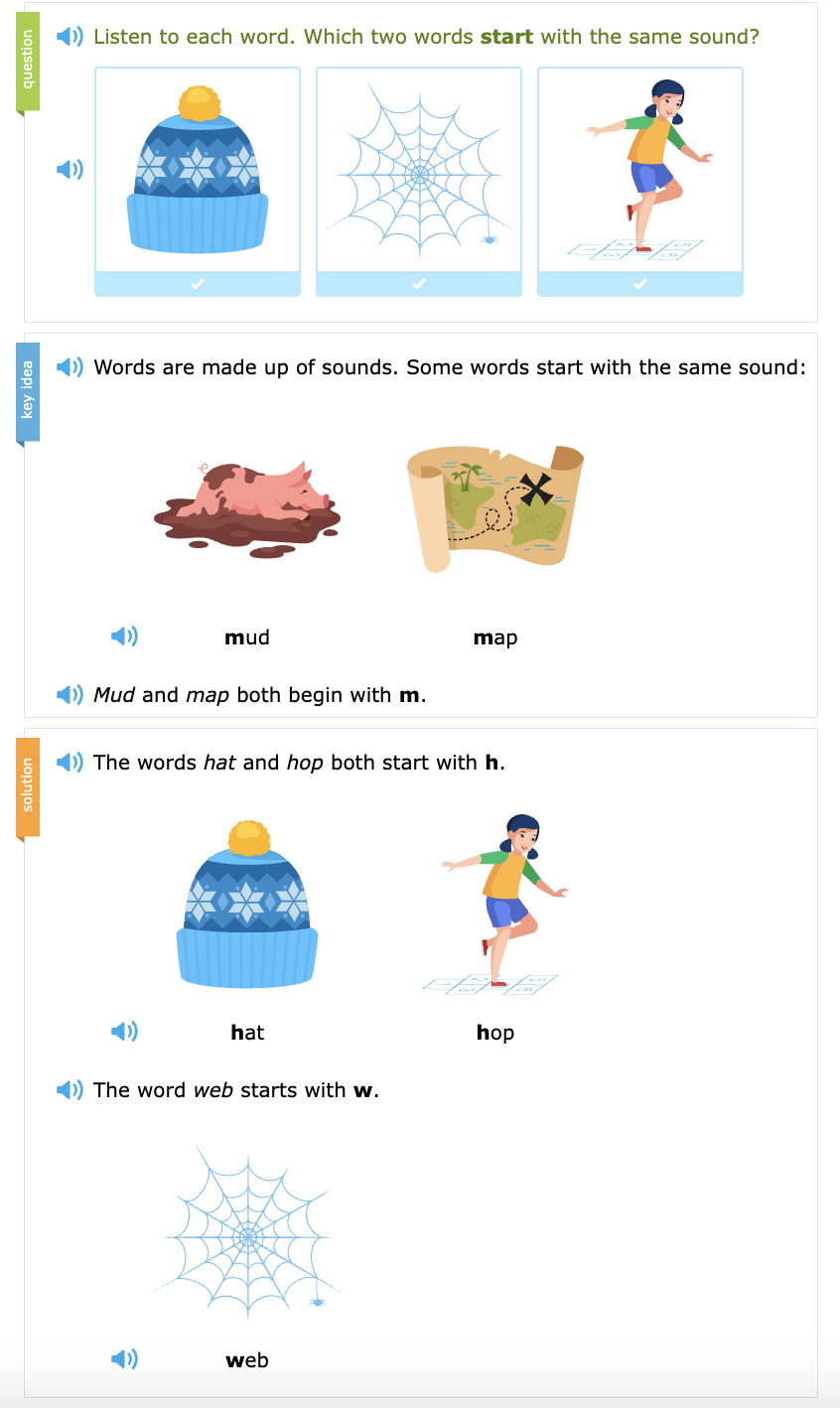
Systematic
IXL phonics skills are arranged in categories and sequenced based on complexity in order to guide students through each step of the reading process. Though students are not confined to a particular learning path on IXL and all skills are available to them, students can follow a systematic approach by completing the skills in order.
And even for a particular concept, IXL offers multiple carefully scaffolded skills that give students varied opportunities to approach the sounds in words—by listening, reading, or spelling them.
For example, when learning the short “a”, students can start by practicing a skill in the Short vowel sounds category, where they listen to words and identify the word with the short ‘a’ sound.
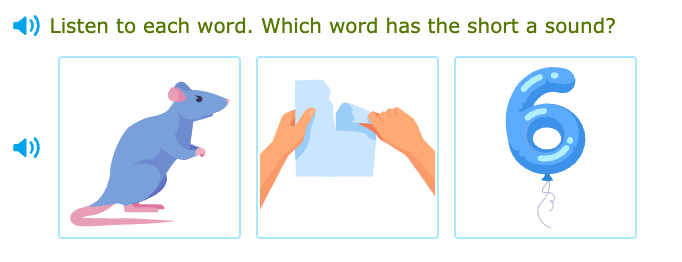
Next, students can then learn to decode short “a” words with four scaffolded skills in the Short a category.
- The first skill in this category focuses on reading simple words with the short “a” sound.
- The second skill in this category focuses on reading words containing the short “a” sound in “am” and “an” words, which can be tricky.
- The third skill in this category focuses on spelling short “a” words by completing the first letter in the word.
- The fourth skill in this category focuses on reading short sentences with short “a” words.
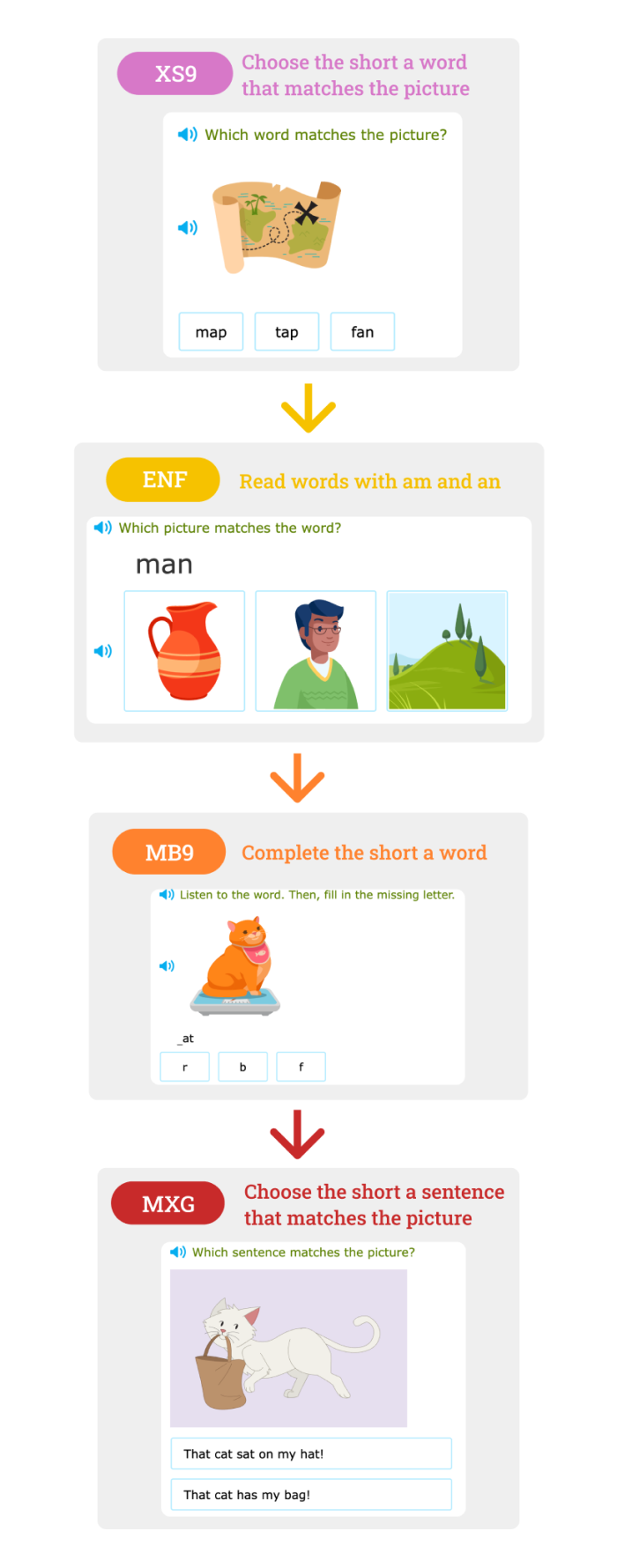
Finally, students can practice reading decodable short “a” stories in the Decodable texts category.
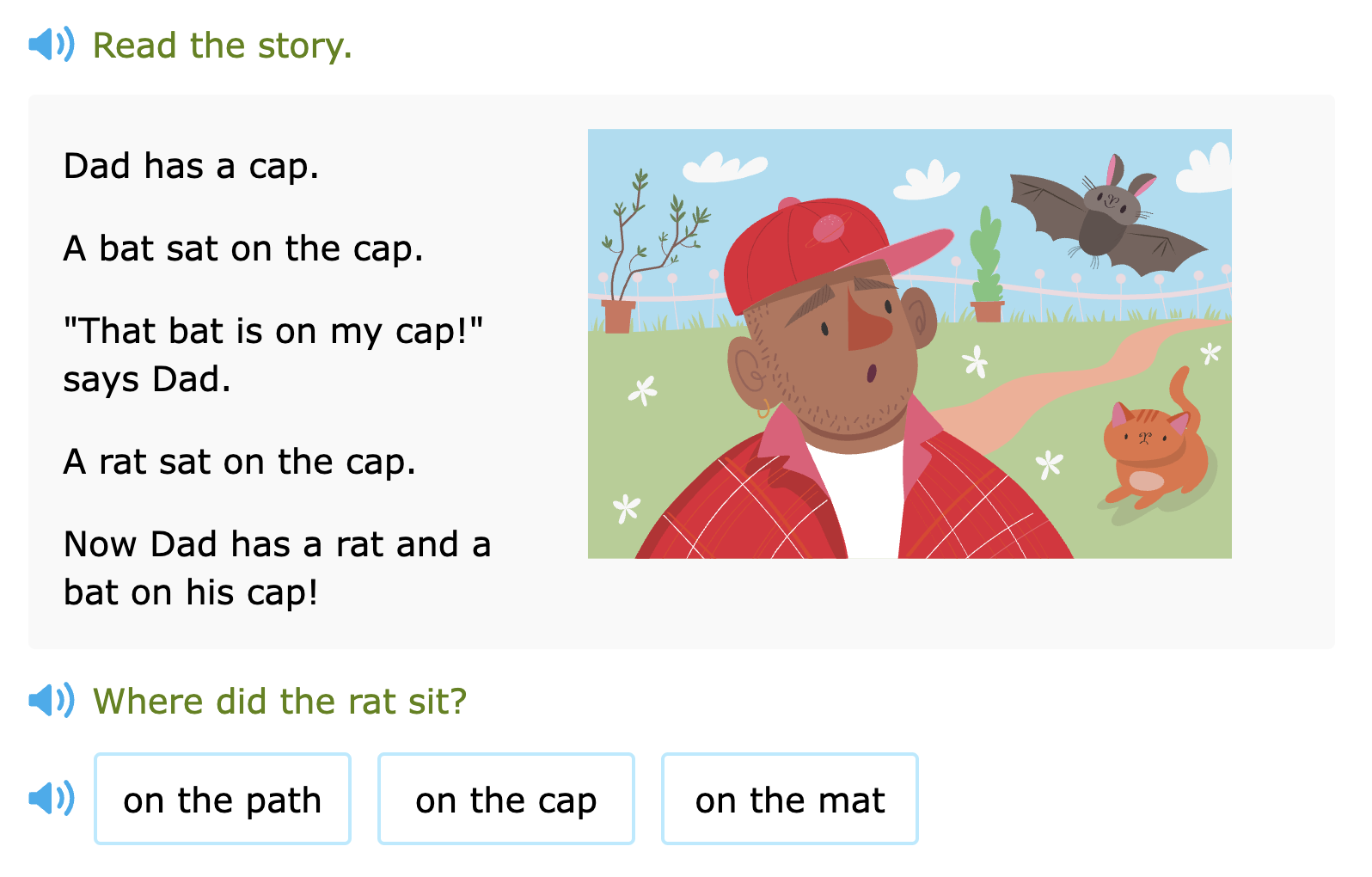
Fluency
Reading fluency refers to the speed and accuracy of decoding as well as the ability to read with expression. Research shows that reading fluency is dependent on the ability to quickly recognize words. Research also indicates that the key to developing fluency is lots of practice with varied texts.
In addition to the phonemic awareness and phonics skills that build the foundation for accurate and quick word recognition, IXL offers sight word skills to help students recognize high-frequency words. The accompanying videos explicitly teach students how to decode each of the words in the skill.
For example, before practicing Read sight words set 2: are, green, on, please, they, students can watch a video that goes through each word one by one and helps students learn how to read them.
Read sight words set 2: are, green, on, please, they (YP6)

In addition, IXL offers “read-along” skills with audio support that highlights each word as it is being read. This allows students to follow along with the text as a professional voice artist models fluent reading.

And finally, IXL’s “read-alone” text skills also give students practice reading a variety of literary and informational texts independently in order to build fluency.

Vocabulary
According to research, the two best ways to improve vocabulary are reading a wide range of texts and receiving explicit word study instruction.
IXL’s read-along skills expose students to a wide variety of texts with rich vocabulary. For example, in this 2nd grade skill, students listen along to a text and practice using context clues to determine the meaning of unfamiliar words:
Read along with realistic fiction (BU7)

IXL’s vocabulary skills also explicitly teach students word relationships and key word-learning strategies, like using word parts or context clues to determine the meanings of unfamiliar words. These skills help students build grade-appropriate vocabulary and bolster their reading comprehension.
Use words with prefixes and suffixes (MRW)
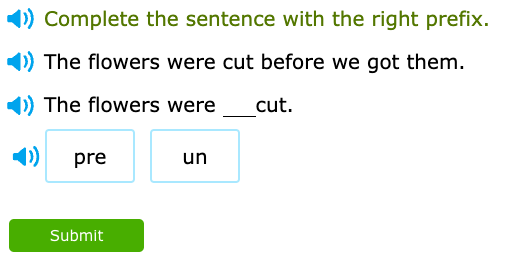
Comprehension
Text comprehension refers to the ability to understand and analyze a text. This is, of course, the ultimate goal of reading. To develop strong comprehension skills, students must master reading strategies like understanding the main idea and making inferences.
IXL’s targeted reading strategies skills break these concepts down to help students truly master them. For example, in this informational-text skill, students learn how to determine the main idea from key details:
Use key details to determine the main idea (DMM)

Students also need exposure to high-quality texts that are rich in vocabulary, sentence variety, and content. These kinds of texts allow students to build vocabulary, develop world knowledge, and practice reading strategies—all of which are crucial for text comprehension.
In each grade level, IXL offers a number of literary and informational text skills in a variety of genres and topics to spark students’ interest and develop their content knowledge.
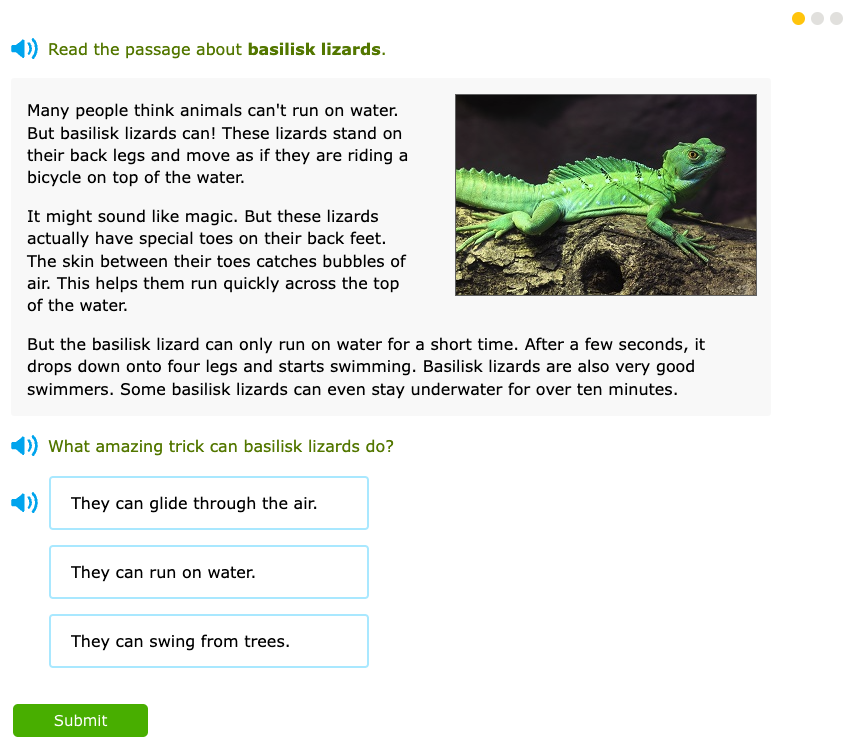
Personalized and supportive instruction
Across all of the areas of reading discussed above, IXL offers personalized instruction with instant feedback, in-skill recommendations, and skill plan options.
Instant feedback
If students miss a question, they receive customized feedback for that specific question. For example, this explanation explicitly teaches students how to map letters with sounds to spell the word bad.
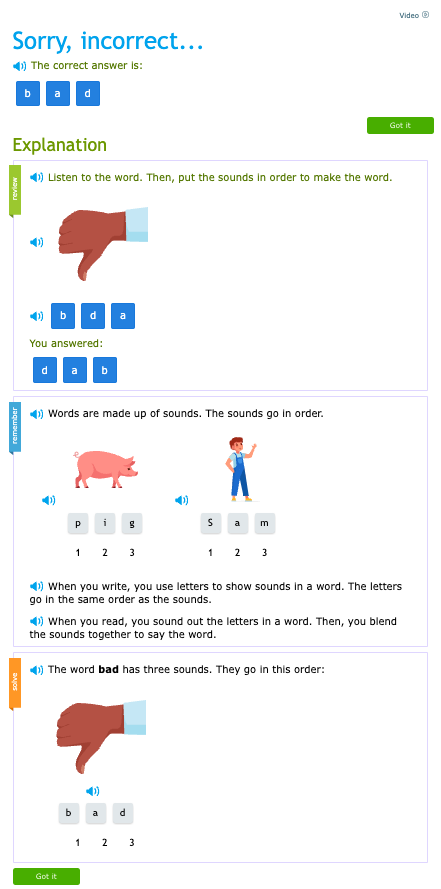
Audio support
As you can see above, audio support is available to read text aloud to students within IXL questions as well as answer explanations. For ELA skills, this support is automatically available through 2nd grade to help early readers, and can be extended through 5th grade as needed.
Skill recommendations
As students work through skills, they are given recommendations for additional skills based on their performance. Students who are struggling with a skill are recommended an easier skill that helps them learn what they need. Students who demonstrate proficiency with a skill are recommended a more difficult skill to deepen their understanding of a concept.
Tip: Research shows that reaching proficiency in 2 IXL skills per week can help students make larger performance gains.
Skill plans
IXL’s skill plans offer students a sequenced approach to the IXL skills. The Learn to read skill plan, in particular, provides a research-based, systematic approach to teaching beginning reading skills and guides students from early letter/sound understanding through reading multisyllabic words and longer text.
Putting it all together
In addition to the five reading areas above, reading research also highlights writing as an equally important part of successful literacy development. IXL’s robust set of writing skills allows students to put their reading skills to practice and make connections between reading and writing.
Whether you’re using IXL to teach students how to read for the first time, to provide remediation for struggling readers, or anything in between—you can feel confident that all the skills you’re assigning are rooted in evidence-based best practices.
Learn more about our English language arts offering here!
